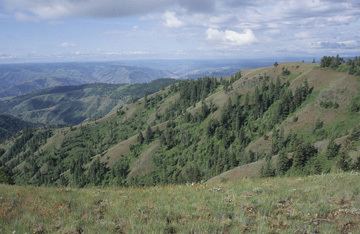Elevation 2,776 m Highest point Rock Creek Butte | Area 10,500 km² | |
 | ||
Mountains Mount Ireland, Strawberry Mountain, Mount Emily, Rock Creek Butte, Van Patten Butte | ||
The Blue Mountains are a mountain range in the western United States, located largely in northeastern Oregon and stretching into southeastern Washington. The range has an area of 4,060 square miles (10,500 km2), stretching east and southeast of Pendleton, Oregon, to the Snake River along the Oregon-Idaho border. The Blue Mountains cover seven counties in Oregon and Washington; they are Union, Umatilla, Grant, Baker, and Wallowa counties in Oregon, and Walla Walla, Columbia and Garfield counties in Washington. They are home to the world's largest organism and fungal mycelial mat, the Armillaria solidipes.
Contents
- Map of Blue Mountains Oregon 97876 USA
- GeologyEdit
- Habitation by Native AmericansEdit
- During westward expansion of the United StatesEdit
- Modern travelEdit
- LocationEdit
- DrainageEdit
- References
Map of Blue Mountains, Oregon 97876, USA
GeologyEdit
The Blues are uplift mountains,.
Geologically, the range is a part of the larger rugged Columbia River Plateau, located in the dry area of Oregon east of the Cascade Range. The highest peaks in the range include the Elkhorn Mountains at 9,108 feet (2,776 m), Strawberry Mountain at 9,038 feet (2,755 m), and Mount Ireland at 8,304 feet (2,531 m). The nearby Wallowa Mountains, east of the main range near the Snake River, are sometimes included as a subrange of the Blue Mountains.
Habitation by Native AmericansEdit
The river valleys and lower levels of the range were occupied by indigenous peoples for thousands of years. Historic tribes of the region included the Walla Walla, Cayuse people and Umatilla, now acting together as the Confederated Tribes of the Umatilla Indian Reservation, located mostly in Umatilla County, Oregon.
During westward expansion of the United StatesEdit
In the mid-1800s, the Blue Mountains were a formidable obstacle to settlers traveling on the Oregon Trail and were often the last mountain range American pioneers had to cross before either reaching southeast Washington near Walla Walla or passing down the Columbia River Gorge to the end of the Oregon Trail in the Willamette Valley near Oregon City.
Modern travelEdit
The range is currently traversed by Interstate 84, which crosses the crest of the range at a 4,193 feet (1,278 m) summit, from south-southeast to north-northwest between La Grande and Pendleton. The community of Baker City is located along the south-eastern flank of the range. U.S. Route 26 crosses the southern portion of the range, reaching a summit of 5,098 feet (1,554 m).
LocationEdit
Much of the range is included in the Malheur National Forest, Umatilla National Forest, and Wallowa–Whitman National Forest. Several wilderness areas encompass remote parts of the range, including the North Fork Umatilla Wilderness, the North Fork John Day Wilderness, the Strawberry Mountain Wilderness, and the Monument Rock Wilderness, all of which are in Oregon. The Wenaha–Tucannon Wilderness sits astride the Oregon–Washington border.
DrainageEdit
The range is drained by several rivers, including the Grande Ronde and Tucannon, tributaries of the Snake, as well as the forks of the John Day, Umatilla and Walla Walla rivers, tributaries of the Columbia.
